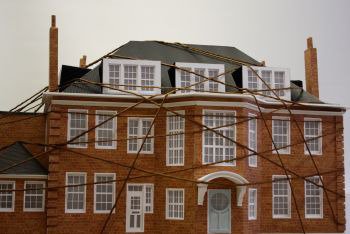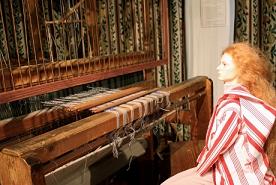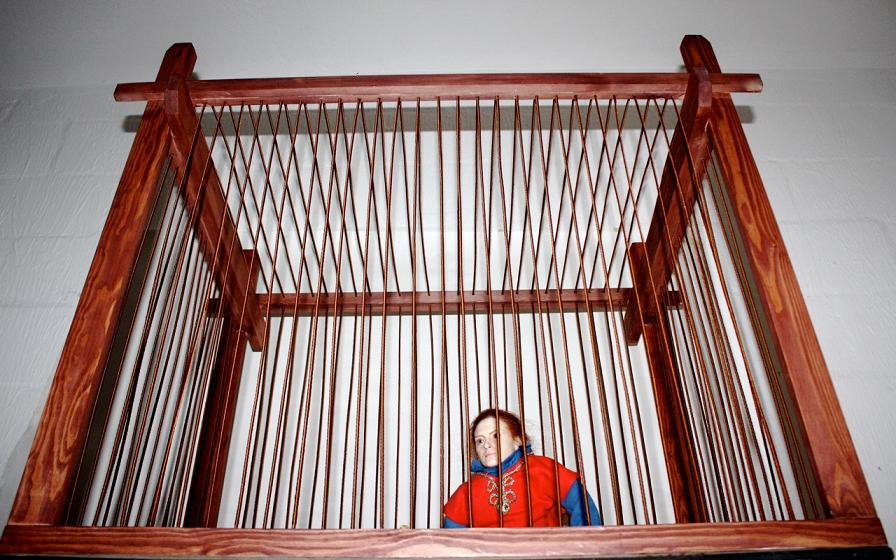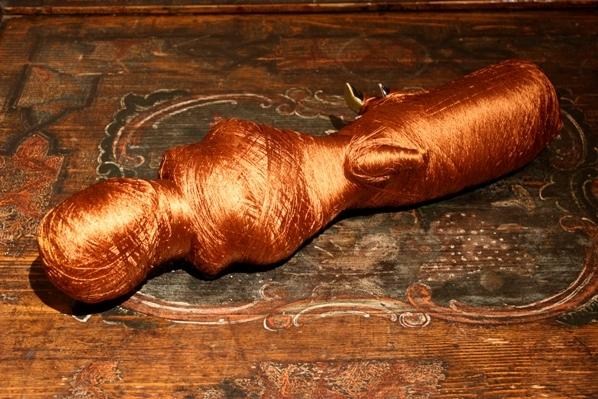Freud’s West Hampstead house is tied up in a cat’s cradle of thick rope. The rope is the same colour as the brick, a deep orange but with a sheeny lustre. It makes the house look not quite real, a Brobdingnagian doll’s house transplanted to this unsuspecting corner of leafy west-London suburbia. It’s an uncanny impression heightened by the pristine condition of its squat, many-windowed façade.
Housebound is the name of this punningly titled "intervention" by Alice Anderson, a 35-year-old French-English artist who now lives in London; and the proffered themes of constraint, imprisonment and entrapment continue as you step inside. A huge spider’s web forms a barely-there barrier to Freud’s former study, where you will glimpse the famous couch and the primitive objet d’art which clutters almost every surface. Amid so many sculptural artefacts one can feel a sense of gloomy oppression, so much so that the artists invited to show here through the years have contributed works that have often been overwhelmed by the surroundings. And they have been defeated not only by the immediate physical space, but by what the space represents.
 But Anderson’s work has a strong, narrative presence and she uses the space cleverly, not seeking to compete, but to complement and challenge its historical narrative. Her primary material is thread and hair, or rather synthetic doll’s hair, yards and yards of it (the rope binding the house), all of which match the colour of Anderson’s own long tresses. So the material is biographical, while her installations and interventions are a kind of fictionalised biography, or perhaps you might call them dream-like memory capsules. These fictionalised memory capsules have been knitted together with associations framed by psychoanalysis and by the lives of the two famous occupants of the house: Freud, who lived here for a year before his death in 1939, and Anna Freud, one of the founders of child psychoanalysis, who lived here until her own death in 1982.
But Anderson’s work has a strong, narrative presence and she uses the space cleverly, not seeking to compete, but to complement and challenge its historical narrative. Her primary material is thread and hair, or rather synthetic doll’s hair, yards and yards of it (the rope binding the house), all of which match the colour of Anderson’s own long tresses. So the material is biographical, while her installations and interventions are a kind of fictionalised biography, or perhaps you might call them dream-like memory capsules. These fictionalised memory capsules have been knitted together with associations framed by psychoanalysis and by the lives of the two famous occupants of the house: Freud, who lived here for a year before his death in 1939, and Anna Freud, one of the founders of child psychoanalysis, who lived here until her own death in 1982.
The downstairs interventions are low key, quietly and insidiously invasive. In a work entitled Parents, two small figures, entwined and "mummified" in orange thread, hang upside down above a long table, like a low-glowing light bulb. On the table there are two tightly wound balls of thread: perhaps representing errant offspring, one is placed at either end. Another figure, similarly trussed, lies prone on an adjacent table (main picture). Its bent legs are tightly bound, though a pair of shoes peek through. The shoes may identify the figure as female, while its trussed penis makes an overt Freudian reference to the female as eunuch. Bent, deformed and anonymous, the female figure enacts the role of sacrificial totem, while other pieces in the room make direct reference to primitive fetishistic objects, an interest Freud himself fostered. Here also is a short film, which features Anderson unravelling thread from a blackened, gangrenous finger in an agitated fashion. At the end of the piece of string a paper butterfly flutters and jerks, but cannot set itself free, cannot follow its natural course.
 All these may seem very obvious tropes, explored and plundered by a past generation of French female artists through their own preoccupations with psychoanalysis and feminism; one thinks particularly of Louise Bourgeois, who also played with scale and used sexualised dolls and reels of thread in her autobiographical work, and Annette Massager whose net (a play on her name) wall hangings are clearly referenced. But what may occasionally seem heavy handed becomes seductive in Anderson‘s hands, for she is a mistress of dramatic narrative and evocative association.
All these may seem very obvious tropes, explored and plundered by a past generation of French female artists through their own preoccupations with psychoanalysis and feminism; one thinks particularly of Louise Bourgeois, who also played with scale and used sexualised dolls and reels of thread in her autobiographical work, and Annette Massager whose net (a play on her name) wall hangings are clearly referenced. But what may occasionally seem heavy handed becomes seductive in Anderson‘s hands, for she is a mistress of dramatic narrative and evocative association.
A dynamic drama is played out between two installations occupying adjacent rooms upstairs. In the first, a wax doll sits at Anna Freud’s hand-loom (pictured above left) - Freud's youngest daughter was apparently a keen weaver - while hair balls of various sizes are scattered about the floor. The wax doll is a scarily realistic self-portrait of the artist in miniature, dwarfed by the loom where she sits at her task, like an archetypal female from a fairytale. Yards of synthetic hair are being woven.
Surrealist and literary references collide, from Paul Nash’s Surrealist painted spheres to the waiting Penelope and the ill-fated Lady of Shalott, and, of course, Rapunzel and Sleeping Beauty.
 In the second room we witness the results of all this tireless weaving. Confinement Room (pictured right) features the artist/doll sitting in a cage whose bars are fashioned from tightly spun hair. Apart from dress, the wax figures are identical, but the loom weaver is perhaps the controlling parent (a mother/daughter theme is a constant in Anderson’s work). Or perhaps the weaver is an alter ego, or, indeed, the super ego to the imprisoned and tamed id. Meanwhile, the walls are hung with abstract grids, again spun from hair. Is this the rigid language of Modernism, both literarily and metaphorically stamping its authority over feminine energy? Or an expression of the irrationality of Surrealism in a face-off with the uncompromising nature of the rationalist grid?
In the second room we witness the results of all this tireless weaving. Confinement Room (pictured right) features the artist/doll sitting in a cage whose bars are fashioned from tightly spun hair. Apart from dress, the wax figures are identical, but the loom weaver is perhaps the controlling parent (a mother/daughter theme is a constant in Anderson’s work). Or perhaps the weaver is an alter ego, or, indeed, the super ego to the imprisoned and tamed id. Meanwhile, the walls are hung with abstract grids, again spun from hair. Is this the rigid language of Modernism, both literarily and metaphorically stamping its authority over feminine energy? Or an expression of the irrationality of Surrealism in a face-off with the uncompromising nature of the rationalist grid?
One may even detect a glimmer of humour in all this earnest referencing, though it can all seem a little clunky in the transcribing. Nonetheless, Anderson’s work is evocative, seductive and darkly enchanting in its reworking of myth and psychoanalysis.
- Alice Anderson's Childhood Rituals at the Freud Museum, London NW3 until 5 June
- Alice Anderson is also showing in Bound with Kate MccGwire at All Visual Arts, King's Cross, London N1 until 5 June
 Find Alice Anderson on Amazon
Find Alice Anderson on Amazon









![SEX MONEY RACE RELIGION [2016] by Gilbert and George. Installation shot of Gilbert & George 21ST CENTURY PICTURES Hayward Gallery](/sites/default/files/styles/thumbnail_125_x_125_/public/mastimages/Gilbert%20%26%20George_%2021ST%20CENTURY%20PICTURES.%20SEX%20MONEY%20RACE%20RELIGION%20%5B2016%5D.%20Photo_%20Mark%20Blower.%20Courtesy%20of%20the%20Gilbert%20%26%20George%20and%20the%20Hayward%20Gallery._0.jpg?itok=3oW-Y84i)





Add comment